Note: If an image ever fails to appear - refresh your page, it really is there
Flags of the Cold War Era
During World War II, the Allies cooperated despite mutual distrust and conflicting ideologies, but after the war ended things fell apart. In the next 40 years the world would see a state of tension and hostility without actual armed conflict directly between the major powers. This became known as "The Cold War."
| Top of Page | Berlin Crisis | China | Korea | Near East | Cuban Missile Crisis | Vietnam War | Cambodian War |
The Superpowers
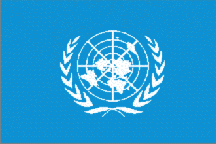
United Nations
|
The United Nations Flag (UN) 1945
At a meeting held in San Francisco in 1945, fifty nations met to draft a charter for a "world peace organization," named the United Nations. It was hoped to make a forum for settling international disputes without armed conflict, to help prevent disease, improve education, protect refugees, and to aid poor nations developing economically.
Click here to learn more about the Organizational Flags of the United Nations and its various Agencies. |
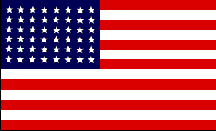
United States of America
(48 Stars)
|
The United States of America Flag (USA) 1912-1959
The United States emerged from World War II as one of the most powerful nations in the world. Only the USSR could compare and these two nations, known as the "Superpowers," began the 40 year long Cold War. United States President Harry Truman, who viewed communism as an "evil force," established the Truman Doctrine in 1947. This policy of containment attempted to stop the expansion of communism into new areas and resulted in the many "police actions" of the Cold War. |

Union of Soviet Socialist Republics
|
The Union of Soviet Socialist Republics Flag (USSR) 1923-1990
The Soviet Union emerged from World War II paranoid and fearful of the Western Powers, whose policies had resulted in two disastrous wars for Russia. Joseph Stalin led them on a policy designed to spread Communism and create a buffer zone of friendly nations around Russia to protect them from future German attacks and western ideologies. Soon the USSR created the "Iron Curtain," as Churchill named it, across Europe and the Cold War was on. |
| Top of Page | Berlin Crisis | China | Korea | Near East | Cuban Missile Crisis | Vietnam War | Cambodian War |
The Berlin Blockade and Airlift 1948
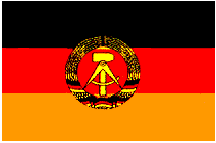
Communist East Germany
|
The German Democratic Republic Flag 1949-1990
At the end of World War II, the USSR set up friendly buffer nations in Eastern Europe. The German Democratic Republic, or East Germany, was one of those "satellite" nations, with East Berlin as its capital. The Soviet Union then basically dismantled East German factories and shipped them back to Russia along with any other resources they could take, then setup a puppet communist government in charge of what remained. |
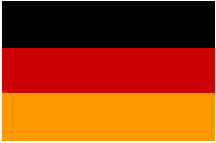
West Germany Civil Flag
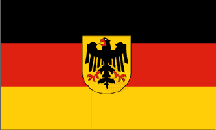
West German War Flag
|
The Federal Republic of Germany Flag 1949-1990
The Federal Republic of Germany, or West Germany, was formed from the Western Allies part of conquered Germany, with Bonn as its capitol. The city of Berlin, located 30 miles inside of East Germany, was divided into West and East Berlin. West Berlin, located on the Soviet side of Germany, was still part of West Germany. Stalin tried to starve the West Berliners into submission during the "Berlin Blockade" in 1948, but the United States successful flew supplies into the beleaguered city in the "Berlin Airlift" until Stalin backed down and lifted the blockade. The Communists built the "Berlin Wall" across the city and it became a symbol of the Cold War. |
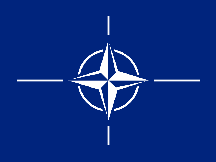
North Atlantic Treaty Organization
|
The North Atlantic Treaty Organization Flag (NATO) 1949
In 1949, the United States, Canada, and nine other Western European countries pledged to help one another if any of them were attacked. This was the start of the North Atlantic Treaty Organization (NATO) which formed because of fears of further Soviet Union aggression.
In 1955 the USSR formed the Warsaw Pact (no flag) with seven of its satellite nations in Eastern Europe as a response. As the arms race began between east and west these organizations faced each other in the Cold War standoff.
The NATO Military Command structure has become fairly large, with many Headquarters and special rapid response units stationed in strategic locations today. Each have special unit flags, some of which can be seen if you (click here). |
| Top of Page | Berlin Crisis | China | Korea | Near East | Cuban Missile Crisis | Vietnam War | Cambodian War |
The Chinese Civil War 1926-1949
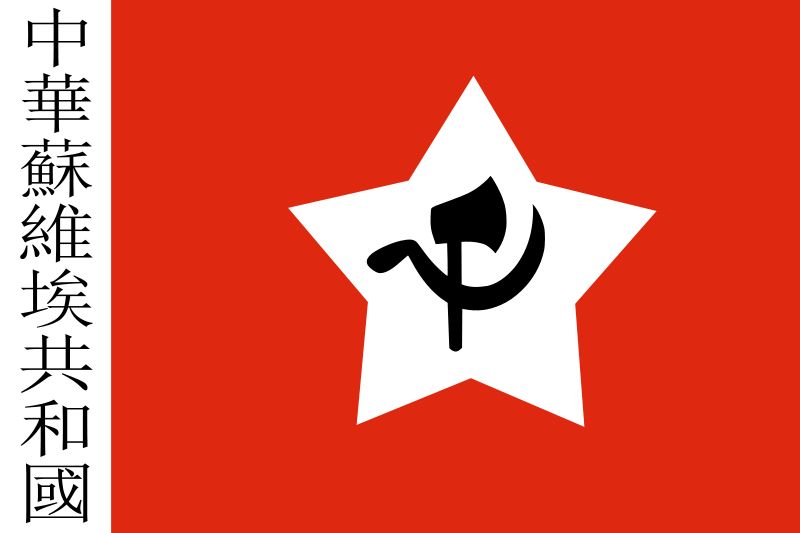
CSR Founding Conference Flag
|
Soviet People's Delegates Conference Flag 1931
Ever since 1926 a civil war had raged between the Communist forces of Mao Zedong and the Nationalist Chinese government. On November 7, 1931 (the anniversary of the 1917 Russian October Revolution), a National Soviet People's Delegates Conference was held in Ruijin, Jiangxi province.
At this conference Ruijin was proclaimed the national capital of the Chinese Soviet Republic, although most of China was still controlled by the Nationalist Government of the Republic of China. An opening ceremony was held for the new country, and this is considered by many as the beginning of the Two Chinas. |
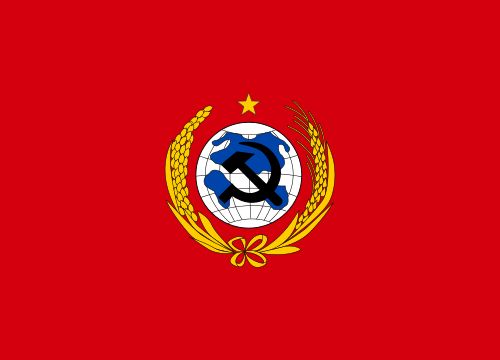
CSR Ensign
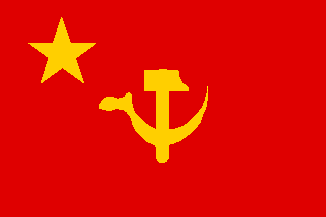
CSR War Flag
|
Chinese Soviet Republic 1931-1937
Zhonghuá Suwéi'ai Gònghéguó
The Chinese Soviet Republic (CSR), or Soviet Republic of China, is often referred to as the Jiangxi Soviet, named for the area in which it was located. It was founded in 1931 by the future Communist Party of China leader Mao Zedong and it lasted until 1937.
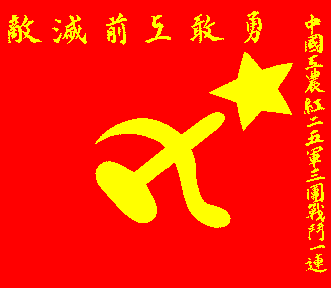 Chinese Soviet Army - 25th Battalion "Fight bravely against your enemy to defeat them"Mao Zedong was both CSR State Chairman and Prime Minister. Mao's tenure as head of this "small state within a state" gave him the necessary practical experience that later helped him accomplish the Communist reunification of China in the 1940s. The CSR was eventually destroyed by the Nationalist Revolutionary Army of the Kuomintang (KMT) in 1937. |

Red China
|
The People's Republic of China Flag 1949
The civil war between the Communist forces of Mao Zedong and the Nationalist Chinese government continued after World War II, with the leadership of the Nationalist government given to General Jlang Jieshi.
In 1949, Mao took Peking (Beijing) and proclaimed the People's Republic of China (Red China). The Nationalist forces retreated to the Island of Taiwan. Mao instituted a series of popular political, social, and economic reforms. |

CPC Flag 1996
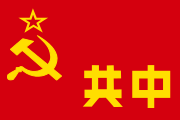
CPC Flag (variant)
|
Communist Party of China (CPC)
This is the current Chinese Communist Party flag. The Communist Party of China (CPC), is the ruling political party of the People's Republic of China (PRC). It is the world's largest Communist political party. While not the official governing body of China under their constitution, it is the de facto supreme political power in the PRC through its control of all state departments and the legislative process.
The Communist Party of China was founded in May 1921 in Shanghai, and came to rule all of mainland China in 1949 after defeating the rival the Kuomintang (KMT) leadership in the Chinese Civil War.
"Power in China is based on a pyramid scheme with supreme power at the top. The Standing Committee of the Politburo holds supreme power. The Committee is responsible for maintaining the Party's control of the state and military. Its members achieve this by holding the highest positions in the State Council, which oversees the government, the National People's Congress, and the Central Military Commission, which runs the armed forces.
The base of the Communist Party includes provincial-level, county-level, and township-level People's Congresses and Party Committees."
|
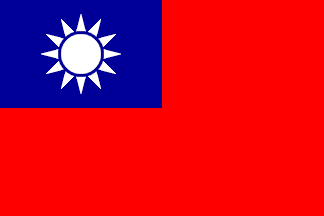
Nationalist China
|
The Republic of China Flag 1928
With their defeat in the Chinese Civil War in 1949, the Nationalist Chinese retreated to Taiwan, establishing an authoritarian one-party state that declared itself to still be the legitimate government of China. However, since that time the Republic of China has transformed itself into a multi-party representative democracy, although relations with mainland China still remain stressed.
The "Blue Sky, White Sun, and a Wholly Red Earth" flag was created in 1906 by Sun Zhongshan (Sun Yat-sen) as a proposal for the flag of future Republic of China, derived from the flag of his party. When the Republic was established in 1912, the design was adopted as the naval ensign. In 1928, it was also adopted as the national flag, while its canton became the naval jack.
|
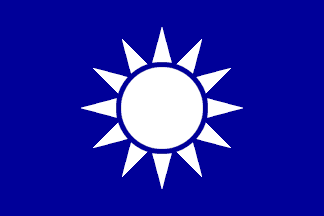
Kuomintang Flag
Also used as the naval jack
|
Chinese Nationalist Party (Kuomintang, KMT)
Kuomintang was founded in Beijing in 1912 by merger of several parties which supported the newly founded Republic. Its policies were based on the Three Principles of the People, developed by its founder Sun Zhongshan (Sun Yat-sen): "People's rule"- freeing China from foreign domination, "People's power" - establishing a democratic state, and "People's welfare" - to be achieved through the reforms in economy. Originally nearly Socialist, the party evolved into a Conservative one under Jiang Jieshi (Chiang Kai-shek), who succeeded to leadership after Sun's death in 1925. By 1928, it managed to reunite the country, previously divided between various warring factions, but engaged in civil war against the Communists, temporarily discontinued during the World War II. Having retreated to Taiwan after the defeat in 1949, the party leadership gradually implemented reforms which resulted in one of currently strongest economies in Asia, but suspended most of democratic processes until the projected re-conquest of mainland, the policy which was abandoned by 1991. After having completed the transition to democracy, KMT remains one of strongest parties in the Republic of China.
The "Blue Sky with a White Sun" flag was designed in 1895 by Lu Haodong (Lu Hao-tung) for the China Reviving Society, founded by Sun Yat-sen previous year, whose merger into the Chinese United League in 1906 and the latter's merger into the KMT in 1912 carried the flag on to these organizations. The same design is used as the naval jack and also occupies the canton of the national flag.
|
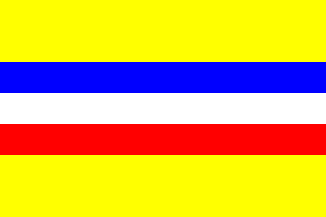
Chinese Youth Party Flag
|
Chinese Youth Party
Although virtually a one-party state until 1987, the Republic of China was not officially such, for two parties were tolerated which had been allied with the Kuomintang prior to 1949. One of these was the Chinese Youth Party, or Young China Party, which was founded in 1923 by Chinese students in Paris. Originally one of "Third Way" parties, trying to offer the alternative to both Kuomintang and the Communists, it eventually sided with the Kuomintang and retreated to Taiwan, with a limited impact on the national politics during the following period. After the multi-party system was introduced in 1987, it lost most of its influence, failing to gain elected representation ever since, but still exists, the evidence of which is available online.
The Chinese Youth Party flag, as shown by the photos found on the Web, is yellow, with blue, white and red horizontal stripes in center.
|
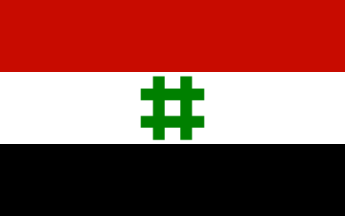
China Democratic Socialist Party
|
China Democratic Socialist Party
The other pre-1949 ally of Kuomintang was China Democratic Socialist Party, which was founded in 1946 by fusion of two earlier parties. Having retreated to Taiwan, it had a limited impact on the national politics, to lose it all after the introduction of multi-party system, when three splits resulted in formation of new parties, reducing the original body to a minuscule form. In 2020, having failed to re-register after the changes in the law regarding political parties, it was disbanded by the Ministry of the Interior.
In the party flag, red stands for warmth and compassion, white for fairness and brightness, and black for determination and discipline. The central symbol, its green color symbolizing peace, is a stylized Chinese character for "well" (井) and stands for the "well-field system", the ancient Chinese method of land distribution in which the division lines resemble the walls of a well. Although it had died out more than 2000 years ago, the system was praised in later times as an early example of social justice and the well symbol has been used in Chinese flags since the early 20th century as the symbol of struggle for a just society.
|
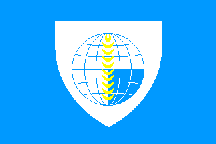
South East Asia Treaty Organization
|
The South East Asia Treaty Organization Flag (SEATO) 1955
The South East Asia Treaty Organization (SEATO) was established at a meeting in Bangkok in February of 1955. Like NATO in Europe, it was primarily created to block further Communist aggression in Southeast Asia. The organization's headquarters was located in Bangkok. Unlike NATO, the SEATO members did not agree to help each other militarily and after the first Vietnam conflict further separated them, SEATO was dissolved in 1977. |
| Top of Page | Berlin Crisis | China | Korea | Near East | Cuban Missile Crisis | Vietnam War | Cambodian War |
Korean War 1950-1953
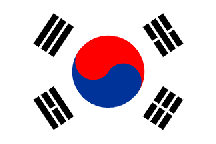
South Korea
|
The Republic of Korea Flag (ROK) 1949
Following World War II, the Korean peninsula was divided in two along the 38th Parallel. The southern half became "Democratic" South Korea, and the northern half became "Communist" North Korea. South Korea, known as the "Land of the Morning Calm,", had its capital in Seoul. The morning calm was soon ended by the first Cold War confrontation to be considered, not a real "war," but a "police" action.
The flag the Republic of Korea adopted was the one used by the old Korean Empire prior to its annexation by Japan in 1910.
|
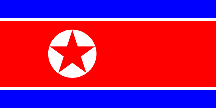
North Korea
|
The Democratic People's Republic of Korea Flag (DPRK) 1949
Communist North Korea had its capital in the City of Pyongyang. They adopted a flag which used the same colors as the old pre-1910 flag, but in a new Communist pattern. In 1950, North Korea invaded South Korea, starting what became known as the Korean War, causing the first United Nations military action against an aggressor nation.
The Korean War lasted three years, and finally ended with a cease fire, but no peace treaty. To this very day the United Nations still stations troops along the DMZ (Demilitarized Zone) to keep it from flaring up again. |
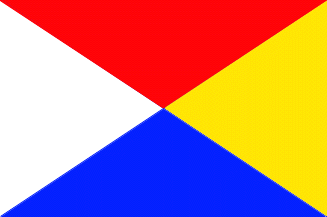
UN Armistice Commission
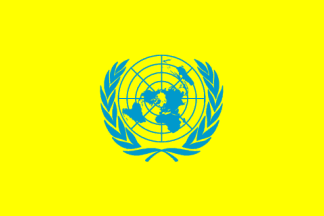
UNCMAC Panmunjeom Flag
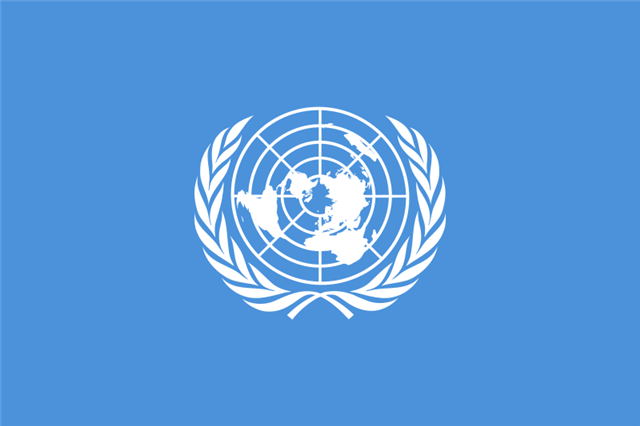
United Nations Flag
|
Flag of the Neutral Nations Supervisory Commission 1953-1954
Between 1953-1954 the Neutral Nations Supervisory Commission (NNSC), originally made up of personal from the countries of Switzerland, Sweden, Czechoslovakia, and Poland, had the role of providing objective observation and reporting on the UN and DPRK's compliance with the armistice. According to the wording of the agreement, "the NNSC shall be composed of four senior officers, two of whom shall be appointed by neutral nations nominated by the United Nations Command (UNC) namely Sweden and Switzerland and two of whom shall be appointed by neutral nations nominated jointly by the Korean People's Army (KPA) and the Chinese People's Volunteers (CPV), namely Poland and Czechoslovakia.
The term "Neutral Nations" was defined as those nations, whose combat forces did not participated in the hostilities in Korea. The Czech component was dropped early in 1993 and the Polish component early in 1995, shortly after these countries established democratic governments following the collapse of the Soviet Union. The main role of the NNSC today is to maintain and to build optimal relations with both sides and keep a channel of communications open between them.
The NNSC flag is a simple combination of the colors of the flags of the original members, Poland (WR), Sweden (BY), Switzerland (RW) and Czechoslovakia (BWR). The Flag design was proposed by Major Marguth in accordance with heraldic principles to the representatives of the Swiss Military and Political Departments.
The United Nations Command Military Armistice Commission (UNCMAC) first represented the UN forces in the armistice discussions with North Korea at Panmunjom, and has continued to represent the United Nations with the Neutral Nations Supervisory Commission. The UNCMAC flag is yellow with the UN emblem in light blue.
United Nations forces still patrol the DMZ (Demilitarized Zone) today, and normally use the standard United Nations flag, not the yellow Panmunjom Flag.
|
| Top of Page | Berlin Crisis | China | Korea | Near East | Cuban Missile Crisis | Vietnam War | Cambodian War |
Cuban Missile Crisis 1962
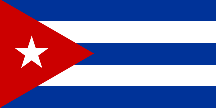
Cuba
|
The Republic of Cuba Flag 1959
Fidel Castro became Prime Minister of Cuba in February of 1959. He had been supported by the US government before they discovered that he was a communist. In 1959, at the end of his last term, President Eisenhower had authorized CIA support of exiled Cubans that resulted in the Bay of Pigs disaster. President John Kennedy took the blame, thus encouraging Nikita Khrushchev, Premier of the Soviet Union, to send military equipment, advisors, and missiles to Cuba. The stage was set for the crisis.
The Cuban Missile Crisis was basically a confrontation between the United States, the Soviet Union, and Cuba during the Cold War. In most of Europe, it is called the "Caribbean Crisis," while in Cuba it is called the "October Crisis." The crisis ranks with the Berlin Blockade as one of the major confrontations of the Cold War, and is often regarded as the moment in which the Cold War came closest to a nuclear war. |
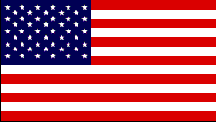
United States of America
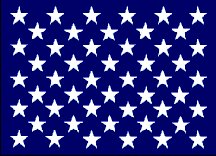
United States Naval Jack
|
The United States of America Flag (USA) 1960
This is the current flag of the United States. This flag became the official United States flag in 1960 when a star was added for the State of Hawaii. It replaced the short-lived 49-star flag (July 4, 1959 – July 3, 1960) honoring the State of Alaska. An Executive Order by President Eisenhower provided for the arrangement of the stars in nine staggered horizontal rows.
The Cuban Missile Crisis began on October 15, 1962, when United States reconnaissance photographs taken by an American U-2 spy plane revealed atomic missile bases being built in Cuba. It ended two weeks later on October 28, when the President of the United States, John F. Kennedy, with help from United Nations Secretary-General U Thant reached an agreement with the Soviets to dismantle the missiles bases in Cuba. In exchange, the US promised that they would not invade Cuba and would secretly remove US missiles from Turkey. The fourteen day long crisis brought the two Superpowers closer to conflict than at any other time during the Cold War.
A jack is a flag that looks like the union or canton of a national flag. For ships of the United States Navy, it is a blue flag containing a star for each state. On warships, the jack is flown from a flag pole (jack-staff) located on the vessel's front end (bow) when at anchor or in port. |
| Top of Page | Berlin Crisis | China | Korea | Near East | Cuban Missile Crisis | Vietnam War | Cambodian War |
Arab-Israeli War (Six Days War) 1967
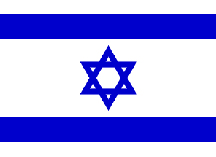
Israel
|
The State of Israel Flag 1947
In 1947, the United Nations approved the partition of Palestine into two states, one Jewish and one Arab. The Arab League rejected the plan, but in May of 1948, the Jewish provisional government declared Israel's independence. The new country's victory in the subsequent Arab-Israeli War expanded the borders of the Jewish state beyond those in the UN Partition Plan. Since then, Israel has been in conflict with many of the neighboring Arab countries, resulting in several major wars and decades of violence that continue to this day.
One such conflict was the Six Days War of 1967, fought between Israel and Arab neighbors Egypt, Jordan, and Syria. At the war's end, Israel had gained control of the Sinai Peninsula, the Gaza Strip, the West Bank, East Jerusalem, and the Golan Heights. |
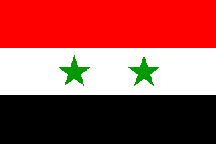
United Arab Republic
|
The United Arab Republic Flag (UAR) 1958-1961
The United Arab Republic (UAR) was a former union between the current-day republics of Egypt and Syria. The union began in 1958 and existed until 1961 when Syria seceded from the union. Egypt (which stayed in the union) continued to be known as the "United Arab Republic" until 1971.
In May of 1967, Egypt expelled the United Nations Emergency Force (UNEF) from the Sinai Peninsula, which had been stationed there since 1957 (following the 1956 Suez Crisis) to provide a peace-keeping buffer zone. Egypt amassed 1,000 tanks and 100,000 soldiers on their border, closed the Straits of Tiran to all ships flying Israeli flags or carrying strategic materials, and called for unified Arab action against Israel. The nations of Jordan, Syria, Iraq, Saudi Arabia, Sudan, Tunisia, Morocco and Algeria also contributed troops and arms to the Arab forces. In June of 1967, Israel launched a preemptive attack against Egypt's air force. Jordan, which had signed a mutual defense treaty with Egypt in May, then attacked western Jerusalem and Netanya. The Israeli response was overwhelming and in six days the Arabs were completely defeated. |
| Top of Page | Berlin Crisis | China | Korea | Near East | Cuban Missile Crisis | Vietnam War | Cambodian War |
The Vietnam War 1955-1975
The Vietnam War followed the First Indochina War (or Anti-French Resistance War) which was fought in French Indochina between 1946-1954. In this colonial conflict, the French Foreign Legion, supported by the Emperor Bao Dai's Vietnamese National Army, fought against the Viet Minh resistance (freedom) fighters, led by Ho Chi Minh. The Vietnam War has also been called the Second Indochina War by some.
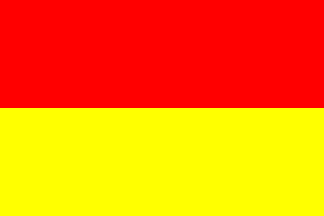
Viet Quoc Party Flag
(1929-1945)
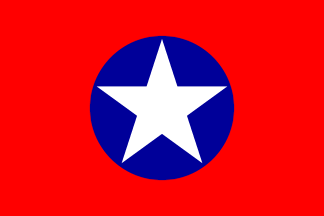
Viet Quoc Party Flag
(1945-present)
|
Vietnamese Nationalist Party 1927-1945
Viet Nam Quoc Dan Dang
Viet Quoc is the shortened form of Viet Nam Quoc Dan Dang (VNQDD), meaning Vietnamese Nationalist Party, which was formed in 1927. Its primary objective was an armed uprising aimed at toppling the French rule of Vietnam, which was part of French Indochina. In 1930, the Viet Quoc were involved in an unsuccessful uprising in Yen Bai, near Hanoi. The leaders were sentenced to death by the French government and most of other participants were imprisoned, many of them as far as in French Guiana. The flag adopted in 1929 during the preparations for the uprising was a red-yellow horizontal bicolor, symbolizing the Vietnamese people and their struggle for independence.
In 1945, the communists, led by Ho Chi Minh, took control of the government of North Vietnam, expelling non-communist parties and executing members of the political opposition. The Viet Quoc took refuge in South Vietnam, and joined the armed forces of South Vietnam from 1954-1975.
Since 1975, the party has remained in exile. Their second flag, which was jointly adopted in 1945 with the Dai Viet Nationalist Party (directly below), with whom they had a very short alliance, has remained in use since then. This is an unusual case of two parties being founded independently, then adopting a common flag which was previously not used by either of them, and eventually both keeping it even after parting ways and becoming exiled. The 1929 flag is still used in exile during the commemorations of Yen Bai uprising, such as the 2010 construction of the memorial to deceased Viet Quoc prisoners in French Guiana. |

Dai Viet Nationalist Party Flag
Horizontal variant
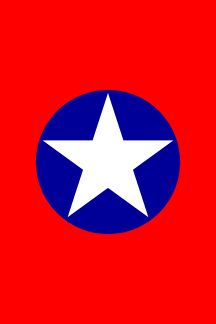
Dai Viet Nationalist Party Flag
Vertical variant
|
Dai Viet Nationalist Party 1939-1975
Dai Viet Quoc Dan Dang
The Dai Viet Nationalist Party was a Vietnamese party, originally formed in Hanoi in 1939, whose goal was restoring the independence of Vietnam (for which they used the pre-1804 name Dai Viet). During this time they took part in several uprisings against the French colonialists.
In 1945, they joined the Viet Quoc (directly above) in an short-lived alliance (they operated as a single party in the Communist-controlled North), jointly adopting the flag currently used by both parties. In the south, the Dai Viet later opposed the Ngô Đình Diệm dictatorship and fell under fierce persecution because of it. Eventually, Dai Viet Party members successfully took part in the 1963 coup, which included the assassination of Ngo Ðinh Diệm and his brother and assistant Ngo Ðinh Nhu.
During the following years, the party participated in several Vietnamese governments, but also suffered from two splits, which resulted in formation of the New Dai Viet Party in 1964 and the Dai Viet Revolutionary Party in 1965
The party still uses the same flag as the exiled Vietnamese Nationalist Party (Viet Quoc - directly above), but since 1975, this party has also been forced to operate in exile. As stated above, this is a rare case of two parties being founded independently, then adopting a common flag which was previously not used by either of them, and eventually both keeping it even after parting ways. The only difference might be that a vertical variant is currently confirmed to be used only by the exiled Dai Viet Nationalist Party; however it must have been used before the exile as well, since such flags have always been popular in Vietnam. |
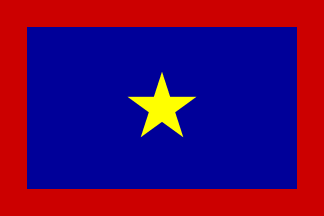
Binh Xuyen Flag
|
Binh Xuyen (Binh Xuyen Troop/Force) c1945-1955
Bo doi Binh Xuyên
In the 1920s the Binh Xuyen started as a loosely organized criminal coalition consisting of hundreds of armed gangs led by various leaders, extortionist and contract killers. Their history consisted of tapestry of piracy, protection services, kidnappings and extortion of rich families, operating brothels, drug smuggling, and assassination. The Binh Xuyen have sometimes been miscalled a sect, but they were not religiously oriented and don't seem to have had much of an actual political ideology outside of a vague Vietnamese nationalism.
One of their most notorious leaders, Ba Duong, become the kingpin of most of South Vietnam by 1945. Under his leadership the Binh Xuyen would eventually make a transition from outlaws to revolutionaries as they became involved in politics between 1945 and 1955.
Under the command of Major General Le Van Lien (also known as Bay Vien), the Binh Xuyen Forces were later recognized as an independent non-communist military force within the Vietnamese National Army. During this time the Bình Xuyen managed to continue to fund itself with its organized criminal activities while also effectively battling Communist forces. In 1955, a month-long battle (often referred to as the Battle of Saigon), between the Vietnamese National Army (later to become the Army of the Republic of Vietnam) and the Binh Xuyen's militia forces resulted in the defeat and disbandment of the Bình Xuyen and their criminal operations. During the Bình Xuyen militia years their flag had a yellow star on a blue field with a red border. |

Dien Bien Phu Flag
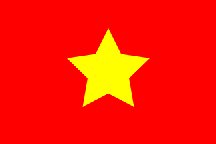
North Vietnam Flag 1945-1955
|
The Viet Minh/North Vietnam Flag 1941-1955
The Viet Minh were communist freedom fighters seeking the liberation of Vietnam from the French who ruled all of Indochina. The movement started in 1941, first to fight the French, and later to opposed the Japanese occupation.
The Viet Minh leader was Ho Chí Minh who successful defeated the French Foreign Legion at Dien Bien Phu. The first Viet Minh flag shown to the left is the flag that flew in triumph over Dien Bien Phu when the French garrison capitulated in May of 1954. The text on the flag translates as "Determined to Fight, Determined to Win." This flag, minus the written text, was the first national flag of North Vietnam.
French public opinion turned against a continuation of the fighting in Indochina after Dien Bien Phu and the French decided to withdraw their troops. They turned the problem over to the United Nations. As a result of peace accords worked out at the Geneva Conference in Geneva, Switzerland, Vietnam was divided into North Vietnam and South Vietnam at the 17th Parallel as a temporary measure until unifying elections would take place in 1956.
|
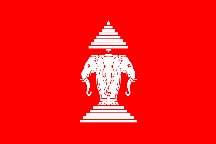
Kingdom of Laos
|
Kingdom of Laos 1950-1975
In 1950 Laos was granted semi-autonomy as an "associated state" within the French Union. However, the French remained in de facto control until 1954, when Laos gained full independence as a constitutional monarchy. A long Laotian Civil War between the Royal Laotian government and the communist Pathet Lao ended officially when the communists won in 1975, removing the king from power (he died in captivity), and forming a strict socialist regime closely aligned to Vietnam. A gradual return to private enterprise and the liberalization of foreign investment laws has taken place in recent years.
The present-day flag of the Lao People's Democratic Republic is shown among the flags of "Allies of North Vietnam" below and was the flag of the Pathet Lao during the Vietnam War. |
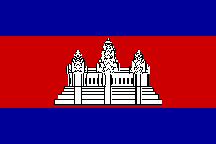
Cambodia
|
The Kingdom of Cambodia Flag 1954-present
Cambodia gained independence from France in 1954, when the United Nations divided up French IndoChina. It became a constitutional monarchy under King Norodom Sihanouk. In 1975, the Communist Khmer Rouge rebels took power and approximately one to three million people were killed by them. Violence and warfare continued throughout the 1980s. United Nations Peace efforts began in 1989, culminating two years later in 1991 in a comprehensive peace settlement. The United Nations was given a mandate to enforce a cease fire, and deal with refugees and disarmament. The stability thus established has mostly remained in place. Money raised in schools and community groups in more developed nations like Japan, France, West-Germany, Canada, Australia and the United States, has gone toward the rebuilding of infrastructure and housing. |
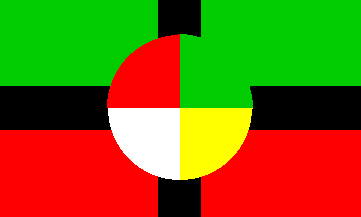
BAJARAKA Flag
Version #1
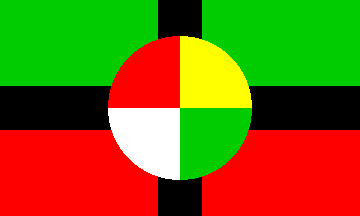
BAJARAKA Flag
Version #2
|
BAJARAKA Movement 1958-1964
The name of this movement is an acronym standing for the Banar, Jarai, Rade and Kaho, four main ethnic groups from the Central Highlands, inland mountainous area which had belonged to South Vietnam. The indigenous inhabitants of this region were previously known as the Montagnards (French for the "mountain people"), the name which is now generally replaced by the self-designation Degar (or Dega). The influence of central government in the area was small until formation of South Vietnam in 1954, when the regime of Ngô Đình Diệm began introducing stronger control, combined with the colonization of ethnic Vietnamese (mostly refugees from the Communist-controlled North) and repression against the Degar. In response to that, BAJARAKA was founded in 1958 to struggle for the autonomy of Central Highlands, under the leadership of Y Bham Enuol, a French-educated Rade civil servant. During next several months, the organization held protests in several towns, only to be banned and its leaders imprisoned.
The flag of BAJARAKA is depicted differently in various sources. While they all agree on the black cross over a green-red horizontal field and the large red-white-green-yellow quartered disc over all, the arrangement of these quarters, precisely green and yellow ones, varies. Version with green above yellow is better known, but probably erroneous, for green quarter merges with the field into a meaningless design there. With yellow above green, the meaning is obvious: the quarters stand for the four represented peoples.
|
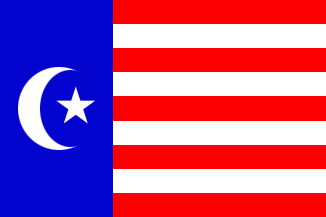
FLC Flag - Type #1
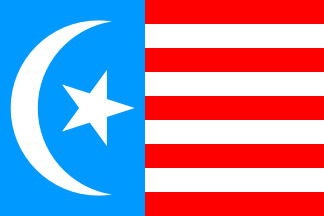
FLC Flag - Type #2
|
Champa Liberation Front
Front de Libération du Champa, FLC
Champa was the name of once powerful kingdom founded in the 2nd century by the Cham people, which comprised central and southern parts of present Vietnam, including the Central Highlands. Through the centuries, it waged wars for the control of Indochina with its Khmer and Vietnamese neighbors, to be destroyed by the latter in the 15th century and reduced to a small vassal principality, eventually annexed by Vietnam in 1822. Many Chams, fleeing from the destruction of their country, settled in Cambodia and other countries, while the remaining population became a minority in Vietnam. Still the gloriuos past was not forgotten and in the late 1950's, with the increasing repression over the minorities in South Vietnam, Champa Liberation Front was founded with the aid of Cambodian Chams, who had also secured the support of Sihanouk government. The leader of FLC was Les Kosem, a Cham officer in the Cambodian Army, who later also played a great role in creation of the United Front for the Liberation of Oppressed Races.
While the details of design vary depending on the sources, the FLC flag is always shown with the field composed of five red and four white stripes and a blue vertical field at the hoist, charged with white crescent and star, the symbols which might stand for Islam, the religion followed by many Chams, although many, especially those in Vietnam, still follow Hinduism, their original religion. It resembles the flag of the Federation of Malaya (1950-1963), which may have provided the inspiration for design, as the two peoples have, beside the religion, other common features as well, most notably similar languages. In turn, the FLC flag may have inspired that of the Highlands Liberation Front.
|
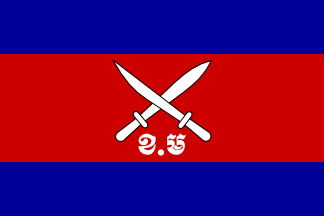
KKLF/FLKK Flag
|
Kampuchea Krom Liberation Front (KKLF)
Front de Libération du Kampuchea Krom, FLKK
Kampuchea Krom means "Lower Cambodia" in Khmer. This name is used for the southernmost part of Vietnam, including the city of Saigon. It had originally been part of Cambodia until early 18th century, when it was conquered by Vietnam, which lost in to France in 1862. Under the name of Cochinchina, the territory remained French colony until 1946, when a puppet state was proclaimed, which united with the rest of Vietnam in 1949. At that time, Khmer people were still a sizable community despite long-lasting Vietnamese assimilation and colonization, and White Scarves (Kaingsaing Sar), a resistance group which was both a religious order and a militia, were founded in the late 1950's by Buddhist monk Samouk Sen. Under the leadership of former monk Chau Dara, they had reorganized as the Kampuchea Krom Liberation Front (KKLF) by 1964, when they joined the United Front for the Liberation of Oppressed Races.
The KKLF/FLKK flag was derived from that of Cambodia by replacing the depiction of Angkor Wat temple with two crossed swords and two initials in Khmer script.
|
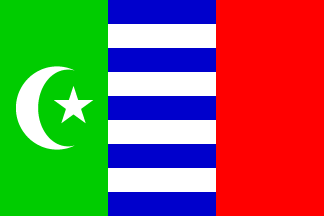
FLHP Flag
Type #1
|
Highlands Liberation Front 1964
Front de Libération des Hauts Plateaux, FLHP
After the overthrow of Ngô Đình Diệm in 1963, leaders of BAJARAKA were released and several of them given government posts, as the new regime tried to approach the Degar. In 1964, BAJARAKA was reinforced by activists from all Degar peoples, as well as the neighboring Chams, and reorganized as the Highlands Liberation Front. Part of the members, including the leader Y Bham Enuol, were for the peaceful activities, but the others, led by Y Dhon Adrong, wanted the armed struggle and set up a base in Cambodia. There they were approached by the Champa Liberation Front and the Kampuchea Krom Liberation Front, whose calls for co-operation resulted in the creation of the United Front for the Liberation of Oppressed Races.
|
|
|
FLHP Flag - Type #2 |
|
FLHP Flag - Type #3 |
The FLHP flag consisted of three fields: in the hoist, white crescent and star on green; in center, blue and white stripes; and in the fly, plain red. Many details varied, as can be seen in contemporary photos: flag ratio, size, shape and orientation of crescent and star, and number and relative width of blue and white stripes. The design may have been inspired by that of the Champa Liberation Front, or by some other flag used by Cham people.
|
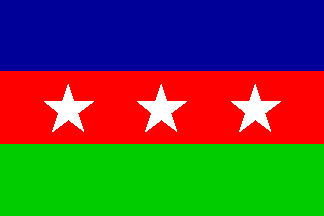
FULRO Flag
Earlier variant

FULRO Flag
Later variant
|
United Front for the Liberation of Oppressed Races 1964-1992
Front Unifié de Libération des races Opprimées, FULRO
In 1964, the contacts were made between the Highlands Liberation Front dissidents in Cambodia and the Champa Liberation Front and Kampuchea Krom Liberation Front. These quickly led to the formation of FULRO, which gathered all of these groups. This was backed by Cambodian government, which hoped both to counter dissident groups attacking from Vietnam, as well as to eventually reconquer Kampuchea Krom area. Shortly afterwards, a mutiny had begun amoong the US-trained military units composed of the Highlands people, the deserters joining the FULRO. Republic of the Highlands and Champa was proclaimed, with Y Bham Enuol as the President and supreme commander. The uprising continued with varying intensity and the negotiations with Saigon government began in 1967, the agreement on recognition of minority rights being reached the next year. Still the opponents of negotiations continued the fighting, putting Y Bham Enuol under house arrest in Phnom Penh. Another agreement, signed in 1969, did not end the conflict and neither did the 1970 coup in Cambodia, for the Lon Nol government supported reconquest of Kampuchea Krom and creating a renewed Champa out of the rest of South Vietnam. The uprising was much more harmed in 1975, by the victory of Viet Cong, which the FULRO also opposed, and by the Khmer Rouge takeover of Cambodia, when the FULRO fighters fleeing from Vietnam were systematically massacred, as well as those already in the country, Y Bham Enuol even being pulled out of French embassy by force to be executed. Still the weakened insurgency continued, now with the support by Khmer Rouge during their war against Vietnam, even securing some aid from China, but that did not last long. Lacking supplies, the number of insurgents kept decreasing until 1992, when their last base in Cambodia was visited by American journalist Nate Thayer, from whom they eventually learned of Y Bham Enuol's death 17 years earlier. Only then did they decide to give up armed struggle, surrendering their weapons to the UN peacekeepers in Cambodia. Many of them were subsequently given asylum in the USA.
In the FULRO flag, blue originally stood for the sea and green for the mountains, while red symbolized the struggle of Montagnards/Degar, Chams and Khmer Krom, who were represented by three white stars. Blue was later changed into black to symbolize the loss of coastal areas and restriction of minorities to the inland mountains.
|
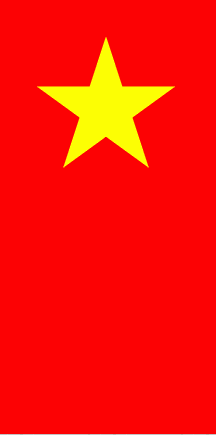
North Vietnam Vertical Banner
|
The Democratic Republic of Vietnam (DRVN) Flag 1955-1975
The Socialist Republic of Vietnam (SRV) 1975-present
Following the partition of Vietnam in 1954, Communists led by Ho Chí Minh gained control of North Vietnam, and thousands of Vietnamese began migrating either north or south. Those moving north aligned with Ho Chí Minh in Hanoi (Hà Noi), while those moving south joined the Saigon government of the Catholic leader Ngo Ðinh Diệm. Warfare broke out between the two new countries, and the United States soon became involved. With the fall of Saigon in 1975, South Vietnam merged with North Vietnam to form a single nation officially called the Socialist Republic of Vietnam, or more commonly simply called Vietnam.
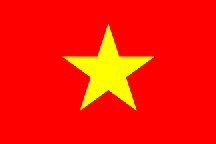 North Vietnam Flag 1955 The Democratic Republic of Vietnam (DRVN) Vertical Banner between 1955-1975 (The Socialist Republic of Vietnam SRV Banner 1975-present) was and is used as a decorative hanging on walls during ceremonies and official events. The ratio is approximately 2:1, the star's center is more or less at the bottom of the first quarter. |
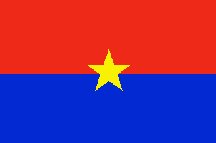
Viet Cong Flag - Type #1

Viet Cong Flag - Type #2
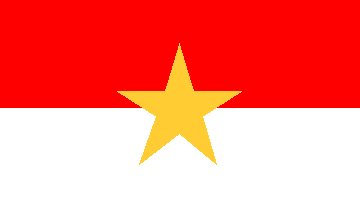
Viet Cong Flag - Type #3
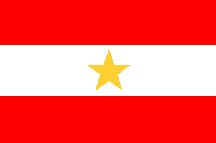
Viet Cong Flag - Type #4
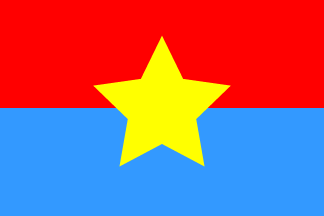
Viet Cong Flag - Type #5
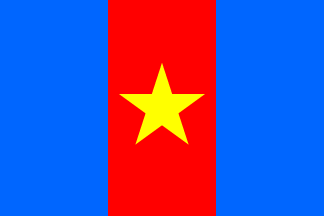
Viet Cong Flag - Type #6
|
The National Liberation Front Flags 1955-1976
The Viet Cong, or National Liberation Front, was the patriot/rebel army based in South Vietnam that fought the South Vietnamese government and the supporting United States troops during the Vietnam War (1959-75). They fought mainly as guerrilla units and rarely as regular army units. They also provided a network of cadre who organized the peasants against the government in the territory they controlled.
The Viet Cong were closely allied with the government of North Vietnam. The group was formed in the 1950s by former members of the Viet Minh acting on orders from Hanoi. They proved highly effective against both ARVN (Army of the Republic of Vietnam) and later against the better equipped American troops.
There were at least six types of flags, probably more, seen being carried by the Viet Cong. Type #1 had a small yellow star centered over a red and blue striped background, Type #2 had a larger white star centered on the red and light-blue striped background, Type #3 had either a large or small yellow star centered on a red and white striped background, and Type #4 had three vertical stripes of red/white/red with a small gold star centered on the white stripe. Like the early flags of the American Revolution, most flags were hand-made and each flag was a little different. Some examples of these variant flags also had Vietnamese text added to them.
The Viet Cong's best-known action was the Tet Offensive, a massive assault on more than 100 South Vietnamese urban centers in 1968. The offensive riveted the attention of the world's media for weeks, but also overextended the Viet Cong who won a propaganda victory while suffering a military defeat against the forces of the United States. The Viet Cong never completely recovered and later communist offensives were conducted primarily by the North Vietnamese army. The Viet Cong was dissolved in 1976 when North and South Vietnam were officially unified.
An interesting story about the Type #3 Viet Cong Flag shown here was that it probably is the only flag ever captured by a hovering helicopter in a combat zone. In 1969, the flag was snatched by a helicopter crew about 100 yards from Firebase Barbara by the door gunner as the helicopter hovered above the flag left on a pole by Viet Cong soldiers. Fearing the flag to be booby trapped, the helicopter crew first exploded a hand grenade near the flag before swooping down to grab it. The pilot was Warrant Officer Harry Oberg of the First Brigade, First Air Calvary, stationed near Tay Ninh, Vietnam. Apparently, some people will do anything to get a souvenir flag.
The Type #4 flag was seen occasionally in the northern part of South Vietnam, especially around the old imperial capitol of Hue, where one was captured by marines involved in the fighting there during the Tet Offensive. It was unusual because it had three, rather than two stripes, and versions of this flag have also been reported with a light pale-blue stripe (similar to the future National Democratic and Peaceful Forces of Vietnam flag of 1968) instead of the white striped version shown here.
The Type #5 Vietcong variant flag was photographed in Tay Ninh in 1969. Note that the yellow/gold star on the flag is the same as on the 1941-1955 flag of North Vietnam. "Charley" (the nickname used by US troops for the Viet Cong), like the "Yankees" of an earlier fight for freedom, had yet to develop any design standards for their early flags.
The Type #6 Vietcong flag has been reported as being used during the Battle of Hue in early 1968. The Vietnamese diaspora websites dealing with the Hue Massacre, the mass killings perpetrated during the Communist hold of the city of Hue during the Tet Offensive, claim that it was hoisted at the Hue Citadel during the occupation of the city by the Viet Cong and North Vietnamese forces. They also attribute it to the Alliance of National Democratic and Peaceful Forces of Vietnam,
which was actually founded after the end of the Tet Offensive, although it shows a different stripe direction and color pattern. It has also been suggested that the same flag was an early variant of the Revolutionary People's Party flag, the Communist Party in the South, which actually predates the flag. |
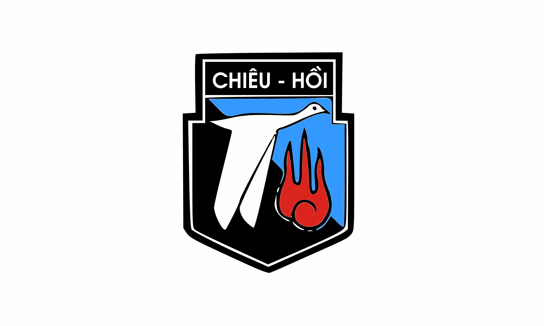
Chieu Hoi Flag

Chieu Hoi Pennant
|
Chieu Hoi (Open Arms) Flag and Pennant 1966-1976
Chiêu Hồi or ciə̯w˧ hoj˧˩
The Open Arms Program, first created by the U.S. Marine Corps in 1966, was part of a campaign attempted by the American military and the South Vietnamese government to encourage defection of Viet Cong and their supporters during the Vietnam War. The results were mixed, by 1967 approximately 75,000 defections had been recorded, but critics of the program speculate that less than 25 percent of them were genuine. By the programs end, however, the number of Viet Cong that did defected under the Chieu Hoi program reached over 100,000.
The most common ways that information about the program was spread was by leaflets, some delivered by special artillery shells or dropped by aircraft over enemy-controlled areas. The propaganda message was also spread via radio messages broadcasted over relevant areas of South Vietnam.
Many of the defectors, known as the Hoi Chanh, were integrated into allied units, called "Kit Carson" or "Tiger" Scouts, and used in the same areas where they had defected, both as intelligence scouts and recruiters for the program. By 1970, 230 Kit Carson Scouts had been killed in action, 716 wounded, and over 2,300 scouts served with U.S. forces. Many of these Hoi Chanh made great contributions to the effectiveness of the U.S. units, and often distinguished themselves, earning military decorations and honors.
|
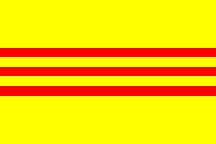
South Vietnam
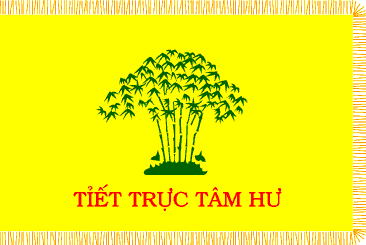
President´s Standard
|
The Republic of Vietnam Flag 1955-1975
Until 1975, South Vietnam was the part of Vietnam south of the 17th parallel. Although, in the popular press, the Republic of Vietnam was called "South Vietnam" and the People´s Republic of Vietnam called "North Vietnam," both governments actually claimed all of Vietnam as their territory. The Republic of Vietnam as proclaimed in 1954 and led by Catholic leader Ngô Ðînh Diệm. It soon was under attack from the North Vietnamese in the north and the Viet Cong from within. American support began in 1954 and then escalated into the Vietnam War in 1958. After Diệm was deposed in a military coup in 1963, there was a series of short-lived military governments, ending with General Nguyen Van Thieu leading the country from 1967 until 1975.
The second flag shown here was not as well-known as the national flag of South Vietnam. It was officially known as the "Republic of Vietnam Presidential Flag." It acted as the South Vietnamese President's official flag and acted as a personal standard for President Ngô Ðînh Diệm between 1955 and 1963. The Vietnamese inscription on the flag means "duty and sacrifice."
During the Military Coup of 1963, President Diệm was killed, and the President´s flag fell into disuse, and was apparently never used by any of his successors after the coups. |

United States of America

Republic of Korea

Australia
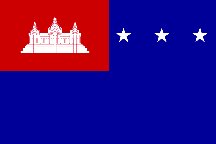
Khmer Republic |
Allies of South Vietnam
The Vietnam War, also known as the Second Indochina War, or the Vietnam Conflict, occurred in Vietnam, Laos and Cambodia from 1959 to 1975. The war was fought between the communist North Vietnam, supported by its communist allies, and the government of South Vietnam, supported by the United States and others.
U.S. and South Vietnamese forces relied on air superiority and overwhelming firepower to conduct search-and-destroy operations, involving ground forces, artillery and air strikes.
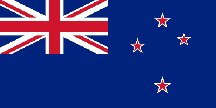 |
|
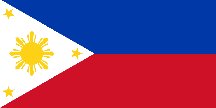 |
| New Zealand |
|
Republic of the Philippines |
|
 |
|
 |
| Thailand |
|
Kingdom of Laos |
The Vietnam War, one of America's longest modern wars, ended in 1973 with the United States withdrawing their troops and abandoning their allies to the northern forces. Fighting continued until 1975 when North Vietnamese forces overran Saigon and gained control of all of Vietnam. Before long, all of Indochina was under Communist rule.
It should be noted that without the backing of the Soviet Union, and especially the Red Chinese, the logistical superiority of the United States would probably have led to a South Vietnamese victory in this struggle. But the Communist north had a consistent resupply of much needed men and supplies, and in the end, the inability of the South Vietnamese and their allies to cut off that supply determined the war's outcome.
|

Red China

USSR

North Korea
|
Allies of North Vietnam
The Viet Cong, the lightly armed South Vietnamese communist insurgency, largely fought a guerrilla war against anti-communist forces in the region. The North Vietnamese Army engaged in a more conventional war, at times committing large-sized units into battle. Usually, conventional tactics led to American and South Vietnamese victories.
 |
|
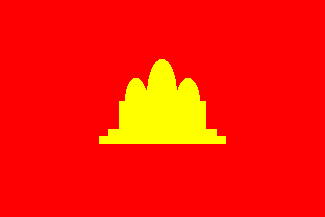 |
Lao People's Democratic Republic
Pathet Lao |
|
Democratic Kampuchea
Khmer Rouge |
This struggle proved once again that determination to persevere no matter how long it takes or costs, will always prevail over government policy without popular public support. The British learn this in the American Revolution, the Spanish learned it in the Netherlands, the French learned it in Spain, the USSR learned it in Afghanistan, and the Americans learned it in Vietnam. In the end, the dissatisfaction of the American people with their governments policies and leaders led to the American withdrawal and North Vietnam's victory. It is unfortunate that the results for the Vietnamese people would be so costly. |
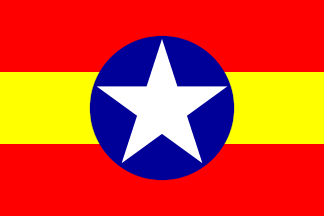
Tan Dai Viet Flag
|
New Dai Viet Party Flag 1964-1975
Dang Tan Dai Viet
The Tan Dai Viet was founded in 1964 after a split in the Dai Viet Nationalist Party. Since 1975, this party also operates in exile. They have a close relationship with the Dai Viet Revolutionary Party, another breakaway group of the Dai Viet Nationalist Party.
The Tan Dai Viet flag is a red-yellow-red horizontal triband with a large blue disc in center, which is charged with a large white star. The design is derived from that of the Dai Viet Nationalist Party flag by combining it with the Republic of Vietnam's national colors. |
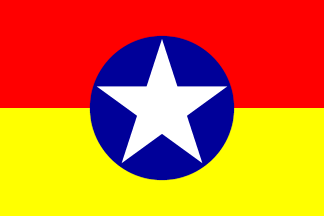
DVCMD Party Flag
|
Dai Viet Revolutionary Party 1965-1975
Dai Viet Cach Mang Dang
The Dai Viet Cach Mang Dang Party was founded in 1965 after a split in the Dai Viet Nationalist Party. Since 1975, this party also operates in exile. The Dai Viet works closely with the New Dai Viet Party, another breakaway group of the Dai Viet Nationalist Party.
The Dai Viet Cach Mang Dang Party flag is a red-yellow horizontal bicolor with a large blue disc in center, which is charged with a large white star. The design is derived from that of the Dai Viet Nationalist Party flag by combining it with the Republic of Vietnam's national colors. |
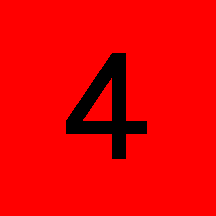
JMC Flag
|
Four Power Joint Military Commission 1973-1975
The Four Power Joint Military Commission (JMC) was set up to monitor the 1973 Vietnam cease-fire. For the critical transition from war to peace, the Paris Peace Accords empowered the commission to oversee the implementation of the cease fire and resolve any differences. The JMC represented each belligerent: the United States, South Vietnam, North Vietnam, and the Viet Cong. After the initial 60 days this commission was replaced by the more international Commission of Control and Supervision (ICCS) consisting of four members: Canada, Hungary, Poland, and Indonesia.
The goal of the ICCS was to peacefully settle any territorial disputes and cease fire violations that occurred until a new civil government could be established in Vietnam. In reality the ICCS lacked any power to do more than report the violations to the Joint Military Commission where final resolution of these and any other matters pertaining to the Accords would ultimately require an unanimous vote of the JMC, and this rarely happened. |
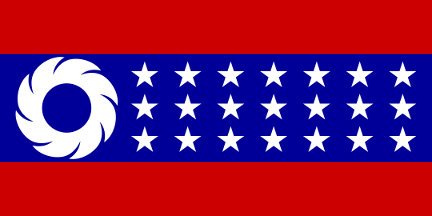
KKNLF Flag *
|
Kampuchea Krom National Liberation Front (KKNLF)
This movement seems to have been founded after 1975 and probably has no connections with the original Kampuchea Krom Liberation Front, whose members mostly withdrew to Cambodia after the fall of Saigon, only to be massacred by the Khmer Rouge; the fact that two movements used different flags also speaks in favor of this. The KKNLF maintained a website from 2004 to 2008, which was also presenting news reports from earlier years (2002-2003), and claimed to have a military camp in Cambodia and office in the USA. The year when its website was closed down is probably also the year when the movement ended its activities.
On the KKNLF flag, blue stands for freedom and democracy and red for the blood spilled in fighting for these ideals. The circular device is chakra, an ancient weapon used as the symbol in Hinduism and Buddhism, and symbolizes strength of the people. The stars represent the provinces within the Kampuchea Krom region.
* Note: Although the Vietnamese KKNLF and the Cambodian KPNLF have very similar names (i.e. both use the name "National Liberation Front") and both were very active in Cambodia during the Cambodian War, these two groups are not the same. The Cambodian KPNLF used what became the current flag of Cambodia. (See Khmer People's National Liberation Front)
|
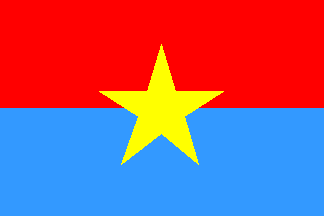
Transitional Flag - June 1975
|
Communist Republic of South Vietnam 1969-1975
In 1969 this flag was adopted for the Communist Republic of South Vietnam and actually became a short lived, but transitional flag of South Vietnam in June of 1975 when the anti-communist regime collapsed. It was quickly replaced a month later when North and South Vietnam were united as the Socialist Republic of Vietnam. At that time the present SRV Flag (plain yellow five-pointed star on red field) replaced it. The Transitional Flag of South Vietnam was again seen briefly in 2005 in news photos of an event marking the 30th Anniversary of the Communist victory.
The flag is basically a red over light blue horizontal bicolor with a yellow five-pointed star centered on it, very reminiscent of variants of the National Liberation Front Flag. |
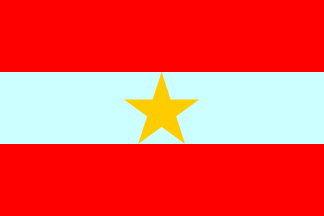
NDPFV Flag 1968-1970
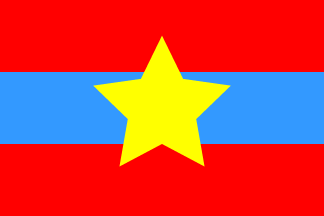
Variant NDPFV Flag
|
Alliance of National Democratic and Peaceful Forces of Vietnam
Lien minh cac Luc luong Dan toc, Dan chu va Hoa bình Viet Nam
In 1968, the Alliance of National Democratic and Peaceful Forces (ANDPFV), created under sponsorship of the National Liberation Front of South Vietnam (Viet Cong), was formed for propaganda purposes in order to attract mainly urban population and to participate in free elections if these were to be held in the South Vietnam. Having decided that it was unlikely to happen, it joined the National Liberation Front in 1969 to form the Provisional Revolutionary Government of the Republic of South Vietnam. After the unification of the country, ANDPFV merged in 1977 with the National Liberation Front and the Vietnamese Fatherland Front (of North Vietnam) to create the present Vietnamese Fatherland Front, which is the Communist-led umbrella organization for all political and other mass organizations in Vietnam.
A flag with three stripes (red/light blue/red) and a yellow/gold star, centered on the light blue stripe or overlapping all three stripes, was used by the Alliance of National Democratic and Peaceful Forces of Vietnam for a short time between 1968 and 1970. It resembles several Viet Cong flags with three stripes which were used shortly before the founding of the ANDPFV and it might have been derived from them. Due to similar designs, these flags are sometimes attributed to the ANDPFV although they actually predate its founding.
|
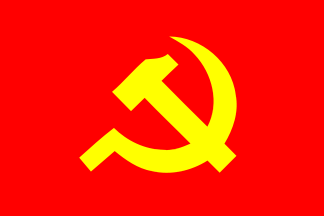
VCP Flag (horizontal)
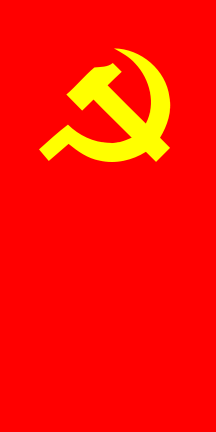
VCP Flag (vertical)
|
Vietnamese Communist Party
Viet Nam Cong San Dang
Vietnamese Communist Party (VCP) is the successor of Indochinese Communist Party (Dong Duong Cong San Dang), which was founded in Hong Kong in 1930 by fusion of several earlier Vietnamese Communist groups. At the Second Party Congress in 1951, it was renamed into the Workers' Party of Vietnam (Dang Lao Dong Viet Nam) in anticipation of founding new Communist parties in Cambodia and Laos. After the partition of country in 1954, the party governed the North as the Democratic Republic of Vietnam, while a People's Revolutionary Party of Vietnam (Dang Nhan Dan Cach Mang Viet Nam) was founded in 1962 to provide the leadership for the revolution in the South. After the reunification in 1976, two parties merged into the Vietnamese Communist Party at the Fourth Party Congress same year.
At the Sixth Party Congress held in 1986, a candid acknowledgment of existing economic problems, and a willingness to change in order to solve them, resulted in a series of reforms aimed at creating a "socialist-oriented market economy". As the result, Vietnam was transformed into one of world's fastest growing economies. Previously a rather isolated country, it has also established diplomatic relations with most nations of the world.
Along with all these reforms, Vietnam has remained a single-party state where only one political party is legally allowed to hold effective power. That party is, of course, the Vietnamese Communist Party. Its official ideology is still the Marxism–Leninism, expanded with the Ho Chi Minh Thought, but the economic reforms have forced it to start describing itself as representing the "interests of the entire people" instead of insisting on workers and peasants only. Still the party control of most of public activities remains unchanged.
Currently, the VCP uses a fairly standard Communist Party flag based on the USSR's classic design of a gold hammer and sickle on a red field. The symbol is placed in center of the flag, similar to those used by the Communist parties in many other Asian countries. Typically for Vietnamese flags, a vertical variant also exists, with hammer and sickle usually moved to the top, although other positions may also be found. This flag, in both variants, was used by both of its predecessor parties in North and South. |
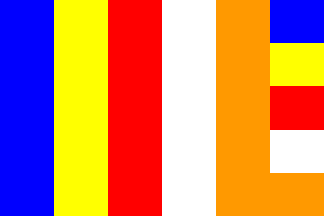
International Buddhist flag
Horizontal variant
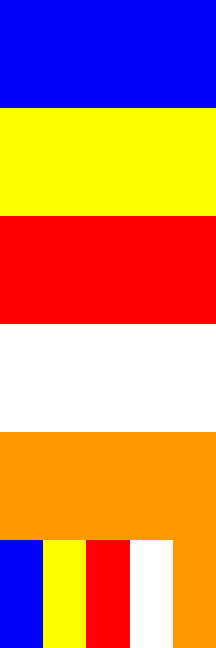
International Buddhist flag
Vertical variant
|
Vietnamese Buddhist 1886-present
In 1884, the Buddhism Protection Committee was formed in Colombo, Sri Lanka, in order to oppose the pressures for Christianization by British colonial authorities. The next year they restored the Vesak holiday celebration, and adopted a flag, which was modified the next year by Colonel Henry Steel Olcott, the President of the Theosophical Society and a patron of the Buddhism Protection Committee. The flag in its final form was first hoisted for the Vesak celebration of 1886. Its colors are believed to be those of the aura which emanated from Buddha's body when he attained Enlightenment - blue, yellow, red, white, orange and pabbhassara (the "essence of light" - a compound color made up of the other five and represented by the multi-colored stripe). When the World Fellowship of Buddhists was founded in 1950 in Colombo, it adopted this design as the International Buddhist Flag.
This flag was in widespread use in Vietnam by the 1960s, when Buddhists in South Vietnam were facing severe repressions by the Diệm regime. President Ngô Đình Diệm, raised as a Roman Catholic, was intent to make his minority religion dominant in the country. There followed forcible conversions, especially in the military, and a general harassment of Buddhists. In 1963, the use of all religious flags were banned in South Vietnam except that of the Vatican, which was classified as a national flag. Violent demonstrations were suppressed by the use of firearms by the police and army. Shortly afterwards, a series of self-immolations by Buddhist monks raised both the people's will to resist and the level of repression. The resulting government attempts to attribute the protests to Vietcong infiltration were not successful, and soon they faced growing pressure from the US government to end the repression. President Diệm, supported by his brother Ngô Đình Nhu (head of the notorious secret police) and Nhu´s wife, who was the acting First Lady, refused to change his policies. The refusal of President Diệm to end the repression eventually led to a coup resulting in the deaths of Diệm and Nhu. The country fell under the control of a military junta until 1967, when its leader Nguyen Van Thieu was elected President, and he remained in that office until 1975.
Although Thieu did not follow his predecessor's policies, and freedom of religion was fully established after the 1963 coup, the damage was done. The new regime´s further inability to establish a truly democratic system, without corruption, was successfully exploited by the Communist and led to their eventual victory. President Thieu resigned shortly before the fall of Saigon and spent the rest of his life in the USA.
In Communist Vietnam today, while religions are still subject to a number of restrictions, Buddhism and its flag has never been banned. A vertical variant, possibly inspired by that of the national flag, can also be seen in use sometimes.
|
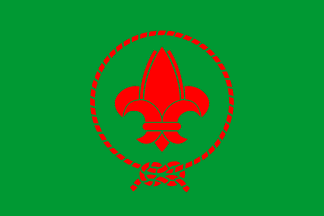
Vietnamese Scout Association
Still used by the Scouts in diaspora |
Vietnamese Scout Association 1930-1975
Hoi Huong Dao Viet Nam
Scouting was brought to Vietnam from France shortly before 1930, when a national association was founded. The movement grew, although during World War II and the First Indochina War, its activities were almost completely stopped. It revived in South Vietnam afterward, but was banned in North Vietnam in 1954. In 1975, with the unification of the country under the Communists, its activities in Vietnam were completely stopped.
Vietnamese Scouting did survive in the refugee camps and subsequently in the countries where the refugees eventually settled down. These new local groups were both attached to their respective host national associations, as well as to the International Central Committee of Vietnamese Scouting, which was founded in 1983. Inside Vietnam, efforts by former Scouts were finally rewarded in the mid-1990s and new Scout groups were founded. Since then, Scouting has been slowly growing, mostly in the southern part of Vietnam, tolerated by the authorities, but still without any official recognition.
The Flag of original Vietnamese Scout Association is green, charged with a fleur-de-lys shaped to resemble a red lotus (which is the Vietnamese national flower) and surrounded with a rope which is tied into a knot at the bottom part of the emblem, all in red. The flag, while still used by Vietnamese Scouts in diaspora, is not used in Vietnam. However, local Scout groups in Vietnam reportedly today use green flags with the red fleur-de-lys emblem and their group designations. |

Cham Flag
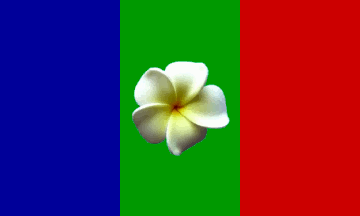
Cham Flag 2017
|
The Cham People (Vietnam)
Urang Campa, Người Chàm
The Chams, or Cham people, are an ethnic group who settled between the 2nd and 15th Centuries in central and southern Vietnam and later in parts of Cambodia. In 1832 the Vietnamese Emperor Minh Mang annexed the last of the Champa Kingdoms and many Cham fled to Cambodia. The Cham community then suffered a major blow during the Khmer Rouge rule of Cambodia when over 100,000 of the remaining Cham population was killed in a senseless attempt at genocide.
During the Vietnam War, in the 1960s, movements emerged calling for the creation of a separate Cham state in Vietnam. The Liberation Front of Champa (Le Front pour la Libération de Cham) and the Highlands Liberation Front (Front de Libération des Hauts) where very active, but since the late 1970s, there is has been no serious Cham secessionist movement or political activity in Vietnam or Cambodia.
The first Cham flag shown here is similar to that of the Highlands Liberation Front, but with black stripes instead of blue, and is used by the Cham diaspora. This flag is especially promoted by the International Office of Champa based in the USA.
Another flag used by the Cham diaspora is promoted by the Council for the Socio-Cultural Development of Champa. It is a blue-green-red vertical tricolor, with the depiction of a yellowish-white flower with five petals in center of green field. This Cham flag was first presented in San Jose, California, in 2017 at the celebration of the 10th anniversary of the organization. |
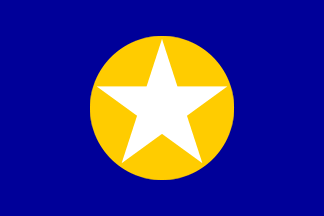
VNP Flag
|
National Party of Vietnam 2003
Dang Dan Toc Viet Nam
The National Party of Vietnam, or Vietnamese Nationalist Party (VNP), should not to be confused with the Vietnamese Nationalist Party of 1927-1941 or the Dai Viet Nationalist Party of 1939-1975. The VNP is a political organization formed in Anaheim, California, by members of the Vietnamese diaspora living in the United States. It was founded by Nguyen Huu Chanh in 2003. These Vietnamese Americans protest against the Communist Vietnamese government, its human rights policy, and those whom they perceive to be sympathetic to it. It is unclear if the NPA still exists.
Its flag is blue, with a large yellow disc in center, which is charged with a large white star, the design very similar to that of the flag used by the Viet Quoc party and the Dai Viet Nationalist Party, only with different colors. |
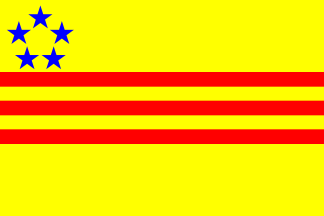
DAV Flag
|
Democratic Alliance of Vietnam 2010
Lien Minh Dan Chu Viet Nam
The Democratic Alliance of Vietnam (DAV) is another political organization of Vietnamese diaspora.
Its flag is derived from the pre-1975 flag of South Vietnam by adding to its canton five blue five-pointed stars arranged in a pentagon. Some variants of the DAV may have the name of organization, along with other inscriptions, in blue above and below the red stripes, but the basic design, without any inscriptions, is also in use. Its logo combines the elements of the flag with the name of the organization, all in a circular device. |
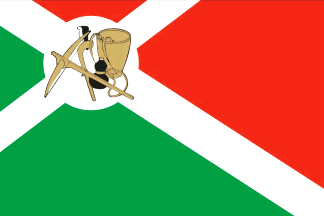
Degar Foundation Flag
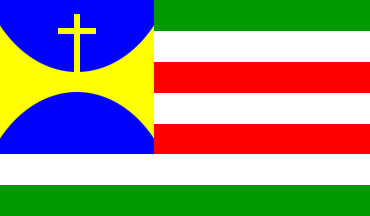
United Montagnard Republic
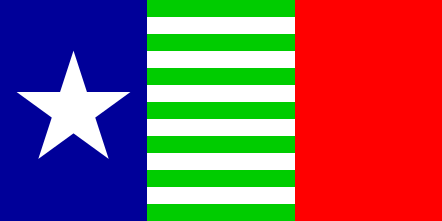
United Montagnard People
|
The Montagnard/Degar People (Vietnam)
Degar, Người Thượng
The Montagnards (French for the "mountain people") or Degar (the self-designation) are indigenous inhabitants of the Central Highlands, inland mountainous area in southern Vietnam; both names are used indiscriminately for a variety of ethnic groups. Having struggled for a self-government during the Vietnam War, they fought against both the anti-Communist government of South Vietnam and the Viet Cong, under the leadership of a series of movements such as the BAJARAKA, the Highlands Liberation Front and the United Front for the Liberation of Oppressed Races. These hostilities, along with the increasing American support towards the end of war, which was intended to make them a barrier to advance of Communism, have led to continuing persecution after the unification of Vietnam, forcing many people to emigrate, mostly to the USA. In present Vietnam, although the Central Highlands peoples are officially recognized as ethnic minorities, there are still numerous reports of human rights abuses, while the area is generally off limit to human rights organizations and reporters.
The Montagnards/Degar in diaspora have founded a number of organizations which seek to alert the world about the problems of their compatriots in Vietnam. The Degar Foundation is probably the best known among these. Founded as the Montagnard Foundation, Inc. in South Carolina in 1990, it officially represented the Degar in the Unrepresented Nations and Peoples Organization (UNPO) from 2003 to 2016. Its flag is diagonally divided red above green, with a white off-center saltire over all, combined with a white disc bearing several traditional tools and weapons. The UNPO connections have made it probably the best known among the Degar flags.
Despite its name, the United Montagnard Republic is probably a fully USA-based organization, without an actual presence in Vietnam. On its flag, red, white and green colors are arranged in horizontal stripes. The yellow symbol on blue canton includes a cross, standing for both the Catholicism, brought by the French in 19th century, and the Protestantism, introduced by the American missionaries in the 1930s. Widespread presence of " foreign" religions among the Degar is an important factor of their integration in American society, but also of their compatriots' difficult situation in Vietnam.
United Montagnard People (UMP) is another USA-based organization of Montagnard/Degar diaspora. Its flag is clearly derived from that of the Highlands Liberation Front, but modified under the influence of USA flag: blue and green colors reversed, number of stripes increased to thirteen and crescent omitted, leaving only the star on blue field. This flag is increasingly being used as a symbol of Degar in general, with many examples of its use unrelated to the UMP or without a clear affiliation. |
- My thanks to Dean Thomas and Tomislav Todorovic for all their valuable input on this section -
| Top of Page | Berlin Crisis | China | Korea | Near East | Cuban Missile Crisis | Vietnam War | Cambodian War |
The Cambodian War 1976-1981
(Cambodian Civil War, Cambodian-Vietnamese War, Third Indochina War, and the Sino-Vietnamese War)
The Cambodian War was the conclusion of a longer struggle, sometimes called the Cambodian Civil War, which saw the forces of the Communist Party of Kampuchea (Khmer Rouge) and their allies, the Democratic Republic of Vietnam (North Vietnam) and the Viet Cong, fighting against the government forces of Cambodia (Khmer Republic 1970), who were supported by the United States and the Republic of Vietnam (South Vietnam) during this period. With the end of the Vietnam War, and the resulting collapse of South Vietnam after the withdrawal of the defeated United States forces, the struggle for Cambodia continued in what was called the Cambodian War (1976-1981), and soon involved an invasion by their former allies, the new Socialist Republic of Vietnam, and a short Chinese invasion of Vietnam.

USSR Flag
|
Union of Soviet Socialist Republics 1922-1991
The Soviet Union (USSR - Union of Soviet Socialist Republics) was, of course, the first of the modern countries to attempt to embrace the teachings of Karl Marx into a political structure called Communism, used in Russia's case to replace Czarism. The experiment ultimately failed, as it quickly became more of a political tool to allow the government to seize dictatorial powers over the Russian people, especially during the Stalin Era. Basically government didn't disappear as Marx envisioned, but basically became stronger and more powerful. As Communism spread it evolved in different ways in different countries. It is only natural that soon rivalries would developed among these different brands of Communism, and one such example developed in the small countries of Indochina, where Mother Russia found herself in completion with the newest and second most powerful Communist State, Red China, in a Cold War struggle of dominance in the area.
With the retreat from the Indochina area of the great Capitalist power of the United States, a power struggle developed between the Soviet Union and Maoist China over the Southeast Asia resources, one of which we label the Cambodian War.
|

PRC Flag
|
Peoples Republic of China 1949-present
The People's Republic of China (PRC) has the largest population in the world. It is located in East Asia. With the end of the Chinese Civil War in 1949, the result was the People's Republic of China, a single-party state governed by the Communist Party of China (CPC). The Communist Party of China (CPC), under the leadership of Mao Zedong, now controlled the the world's second-largest country.
As China's new Communistic government took control of all aspects of Chinese life, it is only natural that they soon looked upon all of eastern Asia as their area of interest. Thus a Cold War rivalry for Communist dominance of the area began to play out in the power vacuum left in Indochina when the French and later the Americans left. Both giant Communist powers wanted to dominate the same area, and Cambodia became one of their un-official political battlefields. |
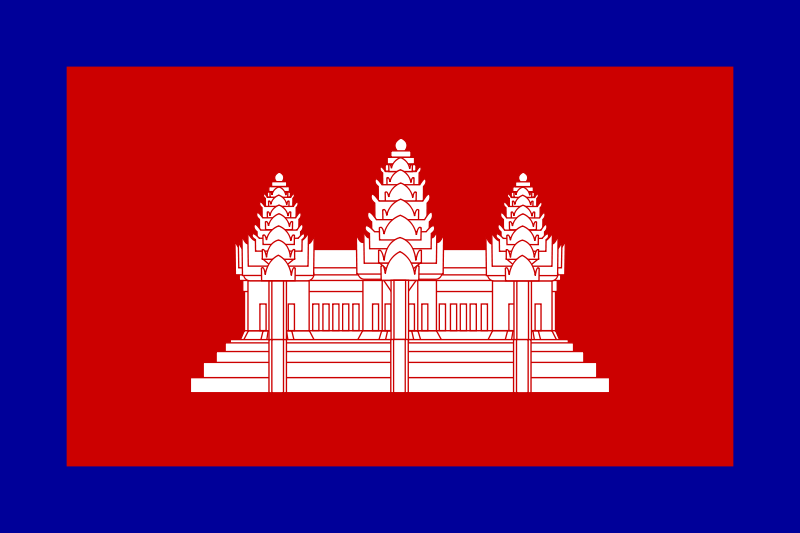
Colonial French Cambodia
|
French Protectorate of Cambodia 1863-1887, 1953
Cambodia has had a very complex and confusing modern history. During the 19th Century it was part of the French colonial empire, as French Indochina, along with Laos and Vietnam. Cambodia, being a "protectorate" of French, was governed by the Resident-General (Résident Supérieur) for Cambodia. Cambodian King Norodom and the later kings of Cambodia were mere figureheads, though they were still viewed as god-kings by the population.
All real power was, however, in the hands of the Resident-General and the French Colonial Office. |
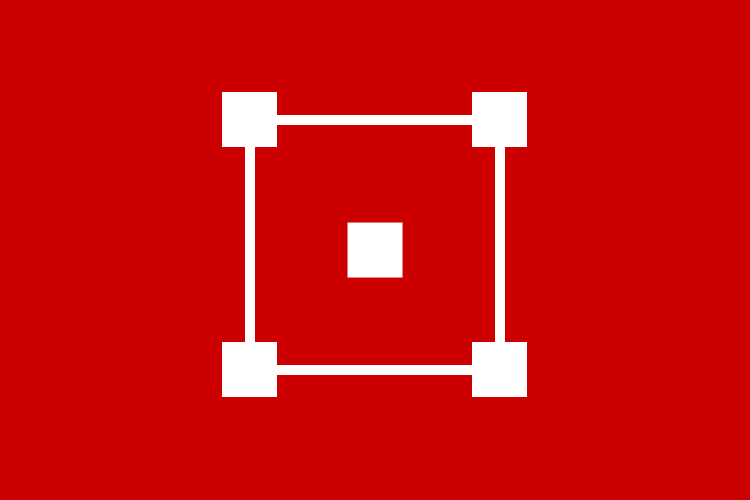
Japanese Occupation Flag 1945
|
Cambodia under Japanese 1941-1945
In World War II, the Japanese occupied French Indochina (including Cambodia) between 1941-1945, before being driven out by the Allies. Since Vichy France, in 1040, became an ally of the Central Powers (Nazi Germany, Austro-Hungary, and Ottoman Turks) and Japan was allied to Germany by treaty, they allowed the Vichy French Indochina colonial officials to remain nominally in charge and administer Cambodia.
Because of this the Japanese occupation in Cambodia, in general, was less brutal on civilians than in other countries of Southeast Asia. With the fall of the Central powers in Europe in 1945, however, the Japanese authorities took complete control of Cambodia and installed a short-lived puppet state. |

Cambodian Flag
|
- Kingdom of Cambodia 1948-1970, 1993
After King Norodom's death in 1904, France manipulated the choice of Cambodian kings. In 1941, Prince Norodom Sihanouk, a maternal grand-son of King Sisowath was chosen to rule, and for many years Prince Sihanouk ruled as the virtual royal King of Cambodia, but he was never crowned as such.
The French thought Prince Sihanouk would be easy to control, but they were wrong, and under is his rule Cambodia eventually gained independence from France in 1953. Sihanouk abdicated in 1955, in favor of his father, after whose death in 1960, he again became Head of State (a Prince, not a King). |

Khmer Cambodian Flag
|
Khmer Republic 1970-1975
République khmére
Between 1970-1975 the country was ruled as the Khmer Republic under the regime of General Lon Nol, who in the Cambodian Coup of 1970, overthrew Prince Norodom Sihanouk. Emergency powers were subsequently invoked by the Prime Minister Lon Nol, who became effectively the head of state. The coup was a turning point in the Cambodian Civil War. Not a monarchy any longer, the formation of the Republic also marked the point at which Cambodia became substantially involved in the Second Indochina War, as Lon Nol issued an ultimatum to Vietnamese forces, which had their bases in Cambodia since 1966, to leave the country.
The brutality of the Lon Nol regime is often cited as a factor in the rise of the Khmer Rouge due to increased anti-rightist and anti-American sentiment among the Cambodian people. During this period of time, numerous nations cut off ties with Cambodia, claiming they only recognized the ousted Royal Government. In 1975, the country was overrun by the Marxist Khmer Rouge who established Democratic Kampuchea, with Prince Sihanouk, once again, the nominal Head of State until 1976, when he was forced to resign. |

Khmer Rouge Flag
|
Democratic Kampuchea 1975-1979, 1991
Democratic Kampuchea is the name of the Khmer Rouge-controlled Communist organization that between 1975 and 1979 ruled Cambodia. It was founded when the Khmer Rouge forces defeated General Lon Nol of the Khmer Republic. Under the leadership of Pol Pot, cities were emptied, organized religion was abolished, and private property, money and markets were eliminated.
After losing control of most Cambodian territory to Vietnamese occupation, Democratic Kampuchea survived as a shadow state supported by China. In June 1982, the Khmer Rouge formed the "Coalition Government of Democratic Kampuchea" with two non-communist guerilla factions, keeping international recognition. The state was renamed back to Cambodia in 1990, prior to the UN-sponsored Paris Peace Agreement Conference of 1991. |
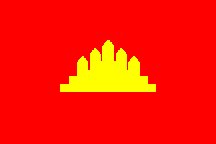
PRK Flag
|
People's Republic of Kampuchea 1979-1989
The People's Republic of Kampuchea (PRK), a Pro-Soviet state led by the Salvation Front, a group of Cambodian leftists dissatisfied with the Khmer Rouge, was established in 1979.
The new regime was welcome by many Cambodians as the end of the terror of the rule by the Khmer Rouge. Despite the lack of a widespread international recognition, as well as a growing anti-Vietnamese sentiment among the people, the new regime managed to survive not only because of foreign support, but also because it did struggle to reconstruct the devastated country. |

Vietnamese Flag

USSR flag
|
Allies of the People's Republic of Kampuchea
In 1978, Vietnamese troops invaded Cambodia, reportedly in response to border raids by the Khmer Rouge. The Khmer Rouge regime was, in turn, overthrown by the invading Vietnamese in 1979 and eventually the puppet regime was set up. This regime was not recognized by the United Nations which assumed control of the country in 1991.

Lao People's Democratic Republic
Besides Vietnam and Laos, the regime was also supported by the USSR and its allies, whose policies were followed during reconstruction and who provided their support in the mostly unsuccessful struggle for
international recognition. Very soon Kampuchea would be one of the countries regarded as socialist, and not just developing, by the USSR. |

Red China Flag

Thailand flag
|
Allies of the Democratic Kampuchea
In opposition to the newly-created state, a government-in-exile referred to as the "Coalition Government of Democratic Kampuchea" (CGDK) was formed in 1981 from three factions. This consisted of the Khmer Rouge, a royalist faction led by Sihanouk, and the Khmer People's National Liberation Front. The Khmer Rouge representative to the UN, Thiounn Prasith, was retained.
The government was formed with support of the People's Republic of China, the old ally of Khmer Rouge, which used the opportunity to oppose the growth of Soviet influence in the region. Not only that, its efforts were crucial in saving the international recognition for its allies. China also launched an invasion of Vietnam in 1979, which had to be abandoned in order to prevent Soviet involvement, but is now often considered as the point of its emergence as a new superpower. The Chinese also promised help to non-Communist countries of the region in case of Vietnamese attack.
Of these allies, Thailand had the greatest role in the conflict. It hosted most of the refugees from Cambodia and the aid to the Coalition Government forces was distributed through its territory. This was much supported by the USA, permanent ally of Thailand, which was not involved directly in the war, although it did recognize the Coalition Government and was backing many international organizations which were aiding the refugees from Cambodia. |
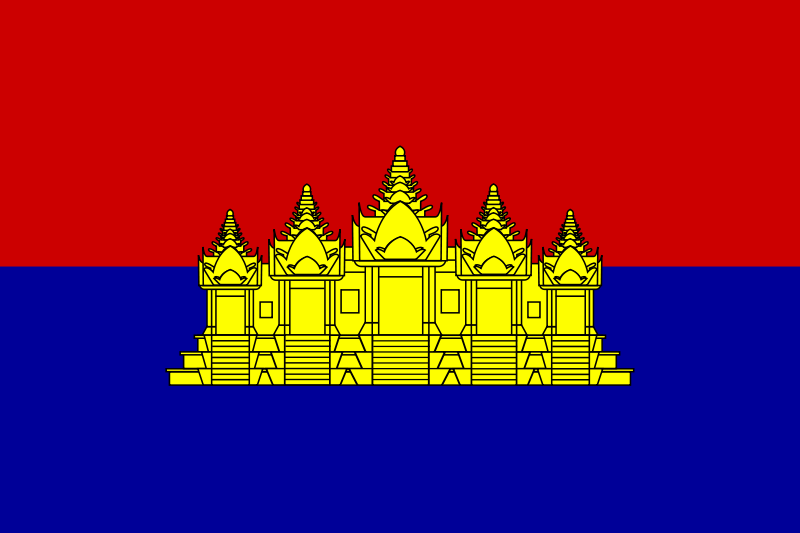
SOC Flag
|
State of Cambodia 1989-1991
État du Cambodge, Roet Kampuchea
The State of Cambodia (SOC), was the official name of the pro-Hanoi "People's Republic of Kampuchea" (PRK) during its transitional times until the restoration of the monarchy (1989-1993) The PRK was renamed as State of Cambodia during the last four years of its existence in an attempt to attract international sympathy. It retained, however, most of its leadership and single-party structure, although it tried to perform some reforms.
The PRK/SOC existed as a communist state from 1979 until 1991, the year in which the ruling single party abandoned its Marxist-Leninist ideology.KPNLF"> |

KPNLF Flag
National Flag since 1993 *
|
Khmer People's National Liberation Front 1979-1993 (KPNLF)
រណសិរ្សរំដោះជាតិប្រជាជនខ្មែរ
The Khmer People's National Liberation Front (KPNLF) was a right-wing, pro-Western, anti-Communist political organization founded in 1979 to opposite the Vietnamese-installed People's Republic of Kampuchea (PRK) government in Cambodia.
Although the 200,000 Vietnamese invading forces were initially welcomed by the majority of Cambodians as liberators, the KPNLF feared the Vietnamese would attempt to completely subjugate the country and soon had begun to oppose their military presence. With the signing of the Paris Peace Agreement in 1991 and the UN sanctioned election held in 1993, the KPNLF was disbanded.
* Note: Although the Cambodian KPNLF and the Vietnamese KKNLF have similar names both calling themselves "National Liberation Fronts," these two groups are not associated with each other. They were from different countries and used different identifying flags. The Cambodian group used what would become the current national flag of Cambodia. See: Kampuchea Krom National Liberation Front |
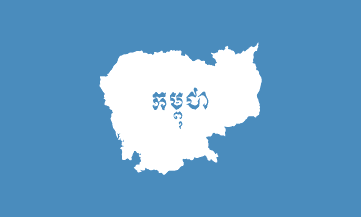
UNTAC Flag
|
United Nations Transitional Authority in Cambodia 1991-1993
The United Nations Transitional Authority in Cambodia (UNTAC) was a United Nations peace keeping operation in Cambodia in 1992-1993. The pro-Hanoi government was not recognized by the United Nations which assumed control of the country in 1992. This was the first occasion in which the UN has taken over the administration of an independent state and assumed responsibility for promoting and safeguarding human rights at the national level.
During the time the country was administered by the United Nations, they used a light blue flag with a map of Cambodia in white on it. Cambodia's name was centered on the map in light blue. |

Cambodian Flag
|
Kingdom of Cambodia - since 1993
Eventually, the United Nations was able to organized and run a free election which was held in 1993 and saw an elected government, consisting of a coalition of Cambodian factions made up of Prince Sihanouk's National United Front Party (FUNCINPEC), Premier's Son Sann's resistance army, and Hun Sen's Cambodian People's Party (previously ruling the State of Cambodia) assume power. Prince Sihanouk was made King of Cambodia again.
The Kingdom of Cambodia today remains a constitutional monarchy with Norodom Sihamoni, an elected monarch, chosen by the Royal Throne Council, as head of state. The head of government is Hun Sen, who is currently the longest serving leader in South East Asia and has ruled Cambodia for over 25 years. |
- My thanks to Tomislav Todorovic for all his valuable input on this section -
| Top of Page | Berlin Crisis | China | Korea | Near East | Cuban Missile Crisis | Vietnam War | Cambodian War |
|